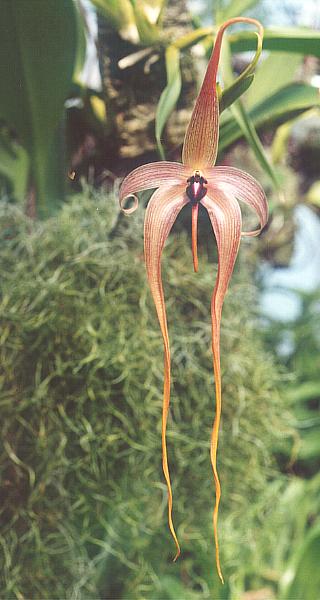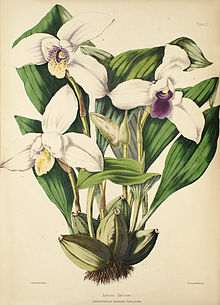
Orchids are plants that belong to the family Orchidaceae, a diverse and widespread group of flowering plants with blooms that are often colourful and fragrant. Orchids are cosmopolitan plants that are found in almost every habitat on Earth except glaciers. The world's richest diversity of orchid genera and species is found in the tropics.

Barbuda is an island located in the eastern Caribbean forming part of the twin-island state of Antigua and Barbuda as an autonomous entity. Barbuda is located approximately 30 miles (48 km) north of Antigua. The sole settlements on the island are Codrington and its surrounding localities. Barbuda is a flat island with the western portion being dominated by Codrington Lagoon, and the eastern portion being dominated by the low-lying Barbuda Highlands, with salty ponds and scrubland spread throughout the island. The climate is classified as tropical marine.

Bulbophyllum is a genus of mostly epiphytic and lithophytic orchids in the family Orchidaceae. It is the largest genus in the orchid family and one of the largest genera of flowering plants with more than 2,000 species, exceeded in number only by Astragalus. These orchids are found in diverse habitats throughout most of the warmer parts of the world including Africa, southern Asia, Latin America, the West Indies, and various islands in the Indian and Pacific Oceans. Orchids in this genus have thread-like or fibrous roots that creep over the surface of trees or rocks or hang from branches. The stem is divided into a rhizome and a pseudobulb, a feature that distinguished this genus from Dendrobium. There is usually only a single leaf at the top of the pseudobulb and from one to many flowers are arranged along an unbranched flowering stem that arises from the base of the pseudobulb. Several attempts have been made to separate Bulbophyllum into smaller genera, but most have not been accepted by the World Checklist of Selected Plant Families.

Laelia is a small genus of 25 species in the orchid family (Orchidaceae). Laelia species are found in areas of subtropical or temperate climate in Central and South America, but mostly in Mexico. Laelia is abbreviated L. in the horticultural trade.

Anguloa, commonly known as tulip orchids, is a small orchid genus closely related to Lycaste. Its abbreviation in horticulture is Ang. This genus was described by José Antonio Pavón and Hipólito Ruiz López in 1798. They named it in honor of Francisco de Angulo, Director-General of Mines of Spain.
Omidiyeh is a city in the Central District of Omidiyeh County, Khuzestan province, Iran, and serves as both capital of the county and of the district.

Miltonia, abbreviated Milt. in the horticultural trade, is an orchid genus comprising twelve epiphyte species and eight natural hybrids. The miltonias are exclusively inhabitants of Brazil, except for one species whose range extends from Brazil into the northeast of Argentina and the east of Paraguay.
The National Film Award for Best Direction is an honour presented annually at India's National Film Awards ceremony by the Directorate of Film Festivals (DFF), an organisation set up by the Indian Ministry of Information and Broadcasting. Since 1967, the award is given by a national panel appointed annually by the DFF to a director for their work within Indian cinema. It is presented by the president of India at a ceremony held in New Delhi.

Bulbophyllum fletcherianum, the tongue orchid, Fletcher's bulbophyllum or Spies' bulbophyllum, is a rare orchid native to southern New Guinea. It prefers sunny rock outcrops or mossy tree branches, but besides being lithophytic or epiphytic, it can also be pseudo-terrestrial. The tongue orchid requires high humidity and moist roots.

Laelia speciosa, commonly known as the Mayflower orchid, is a species of showy orchid found in area of Mexico with high elevation of 1,400 m (4,593 ft) to 2,400 m (7,874 ft). The plant is very drought resistant and can tolerate cool to warm conditions. It blooms from summer to fall, producing fragrant flowers. There are usually three to four flowers on an inflorescence.

Lycaste, abbreviated as Lyc. in horticultural trade, is a genus of orchids that contains about 30 species with egg-shaped pseudobulbs and thin, plicate (pleated) leaves.

Sirri Island, is an island in the Persian Gulf belonging to Iran.

Shahdad is a city in, and the capital of, Shahdad District of Kerman County, Kerman province, Iran.

Necronomicon: The Dawning of Darkness, also known as Necronomicon: The Gateway to Beyond, is a 2000 video game developed by Wanadoo Edition and released for Windows and the PlayStation video game console.

Lycaste aromatica, common name the sweet scented lycaste, is a species of flowering plant in the genus Lycaste of the family Orchidaceae.

The 2012 ASEAN University Games officially known as the 16th ASEAN University Games was a Southeast Asian university multi-sports event held in Vientiane, Laos. This was the first time Laos hosted the games. Laos is the eighth nation to host the ASEAN University Games after Thailand, Indonesia, Malaysia, Singapore, Brunei, Philippines and Vietnam.













